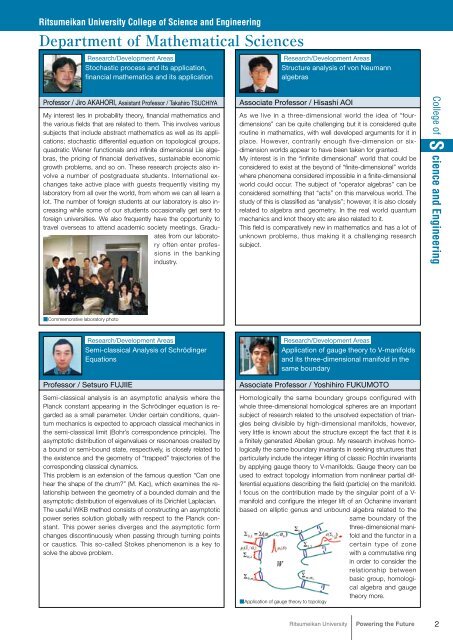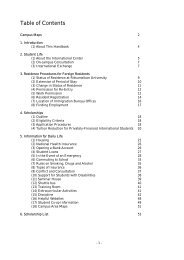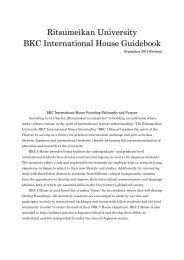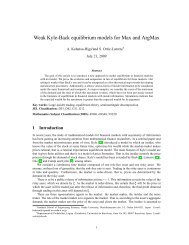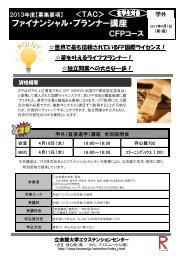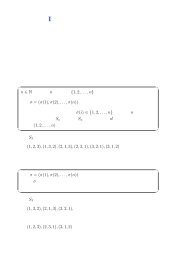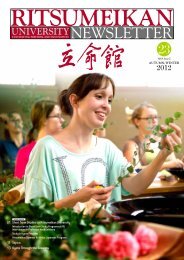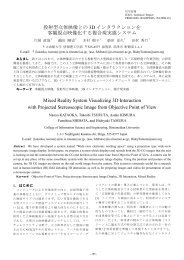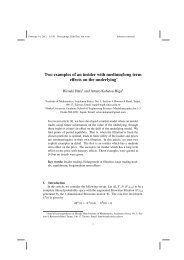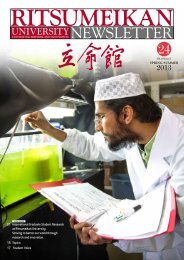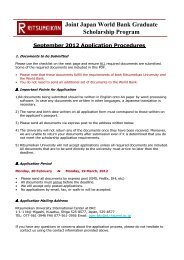Powering the Future - 立命館大学
Powering the Future - 立命館大学
Powering the Future - 立命館大学
You also want an ePaper? Increase the reach of your titles
YUMPU automatically turns print PDFs into web optimized ePapers that Google loves.
Ritsumeikan University College of Science and Engineering<br />
Department of Ma<strong>the</strong>matical Sciences<br />
Research/Development Areas<br />
Stochastic process and its application,<br />
financial ma<strong>the</strong>matics and its application<br />
Research/Development Areas<br />
Structure analysis of von Neumann<br />
algebras<br />
Professor / Jiro AKAHORI, Assistant Professor / Takahiro TSUCHIYA<br />
My interest lies in probability <strong>the</strong>ory, financial ma<strong>the</strong>matics and<br />
<strong>the</strong> various fields that are related to <strong>the</strong>m. This involves various<br />
subjects that include abstract ma<strong>the</strong>matics as well as its applications;<br />
stochastic differential equation on topological groups,<br />
quadratic Wiener functionals and infinite dimensional Lie algebras,<br />
<strong>the</strong> pricing of financial derivatives, sustainable economic<br />
growth problems, and so on. These research projects also involve<br />
a number of postgraduate students. International exchanges<br />
take active place with guests frequently visiting my<br />
laboratory from all over <strong>the</strong> world, from whom we can all learn a<br />
lot. The number of foreign students at our laboratory is also increasing<br />
while some of our students occasionally get sent to<br />
foreign universities. We also frequently have <strong>the</strong> opportunity to<br />
travel overseas to attend academic society meetings. Graduates<br />
from our laboratory<br />
often enter professions<br />
in <strong>the</strong> banking<br />
industry.<br />
Associate Professor / Hisashi AOI<br />
As we live in a three-dimensional world <strong>the</strong> idea of “fourdimensions”<br />
can be quite challenging but it is considered quite<br />
routine in ma<strong>the</strong>matics, with well developed arguments for it in<br />
place. However, contrarily enough five-dimension or sixdimension<br />
worlds appear to have been taken for granted.<br />
My interest is in <strong>the</strong> “infinite dimensional” world that could be<br />
considered to exist at <strong>the</strong> beyond of “finite-dimensional” worlds<br />
where phenomena considered impossible in a finite-dimensional<br />
world could occur. The subject of “operator algebras” can be<br />
considered something that “acts” on this marvelous world. The<br />
study of this is classified as “analysis”; however, it is also closely<br />
related to algebra and geometry. In <strong>the</strong> real world quantum<br />
mechanics and knot <strong>the</strong>ory etc are also related to it.<br />
This field is comparatively new in ma<strong>the</strong>matics and has a lot of<br />
unknown problems, thus making it a challenging research<br />
subject.<br />
College of S cience and Engineering<br />
■Commemorative laboratory photo<br />
Research/Development Areas<br />
Semi-classical Analysis of Schrödinger<br />
Equations<br />
Professor / Setsuro FUJIIE<br />
Semi-classical analysis is an asymptotic analysis where <strong>the</strong><br />
Planck constant appearing in <strong>the</strong> Schrödinger equation is regarded<br />
as a small parameter. Under certain conditions, quantum<br />
mechanics is expected to approach classical mechanics in<br />
<strong>the</strong> semi-classical limit (Bohr’s correspondence principle). The<br />
asymptotic distribution of eigenvalues or resonances created by<br />
a bound or semi-bound state, respectively, is closely related to<br />
<strong>the</strong> existence and <strong>the</strong> geometry of “trapped” trajectories of <strong>the</strong><br />
corresponding classical dynamics.<br />
This problem is an extension of <strong>the</strong> famous question “Can one<br />
hear <strong>the</strong> shape of <strong>the</strong> drum?” (M. Kac), which examines <strong>the</strong> relationship<br />
between <strong>the</strong> geometry of a bounded domain and <strong>the</strong><br />
asymptotic distribution of eigenvalues of its Dirichlet Laplacian.<br />
The useful WKB method consists of constructing an asymptotic<br />
power series solution globally with respect to <strong>the</strong> Planck constant.<br />
This power series diverges and <strong>the</strong> asymptotic form<br />
changes discontinuously when passing through turning points<br />
or caustics. This so-called Stokes phenomenon is a key to<br />
solve <strong>the</strong> above problem.<br />
Research/Development Areas<br />
Application of gauge <strong>the</strong>ory to V-manifolds<br />
and its three-dimensional manifold in <strong>the</strong><br />
same boundary<br />
Associate Professor / Yoshihiro FUKUMOTO<br />
Homologically <strong>the</strong> same boundary groups configured with<br />
whole three-dimensional homological spheres are an important<br />
subject of research related to <strong>the</strong> unsolved expectation of triangles<br />
being divisible by high-dimensional manifolds, however,<br />
very little is known about <strong>the</strong> structure except <strong>the</strong> fact that it is<br />
a finitely generated Abelian group. My research involves homologically<br />
<strong>the</strong> same boundary invariants in seeking structures that<br />
particularly include <strong>the</strong> integer lifting of classic Rochlin invariants<br />
by applying gauge <strong>the</strong>ory to V-manifolds. Gauge <strong>the</strong>ory can be<br />
used to extract topology information from nonlinear partial differential<br />
equations describing <strong>the</strong> field (particle) on <strong>the</strong> manifold.<br />
I focus on <strong>the</strong> contribution made by <strong>the</strong> singular point of a V-<br />
manifold and configure <strong>the</strong> integer lift of an Ochanine invariant<br />
based on elliptic genus and unbound algebra related to <strong>the</strong><br />
same boundary of <strong>the</strong><br />
three-dimensional manifold<br />
and <strong>the</strong> functor in a<br />
certain type of zone<br />
with a commutative ring<br />
in order to consider <strong>the</strong><br />
relationship between<br />
basic group, homological<br />
algebra and gauge<br />
<strong>the</strong>ory more.<br />
■Application of gauge <strong>the</strong>ory to topology<br />
Ritsumeikan University<br />
<strong>Powering</strong> <strong>the</strong> <strong>Future</strong><br />
2


